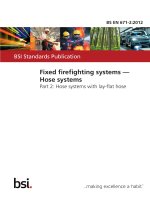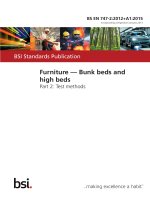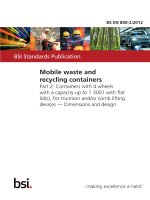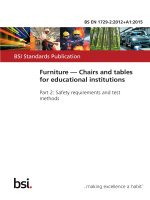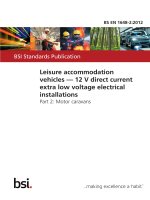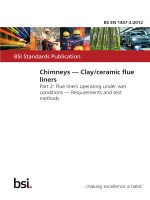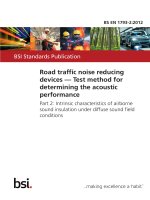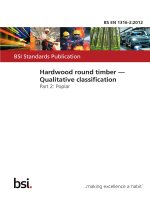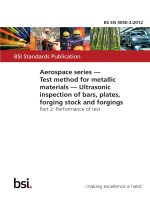Bsi bs en 61915 2 2012
Bạn đang xem bản rút gọn của tài liệu. Xem và tải ngay bản đầy đủ của tài liệu tại đây (1.6 MB, 40 trang )
BS EN 61915-2:2012
Incorporating corrigendum July 2012
BSI Standards Publication
Low-voltage switchgear
and controlgear — Device
profiles for networked
industrial devices
Part 2: Root device profiles for starters
and similar equipment
NO COPYING WITHOUT BSI PERMISSION EXCEPT AS PERMITTED BY COPYRIGHT LAW
raising standards worldwide™
BRITISH STANDARD
BS EN 61915-2:2012
National foreword
This British Standard is the UK implementation of EN 61915-2:2012.
It is identical to IEC 61915-2:2011, incorporating corrigendum July 2012.
The start and finish of text introduced or altered by corrigendum is
indicated in the text by tags. Text altered by IEC corrigendum July 2012
is indicated in the text by ˆ‰.
The UK participation in its preparation was entrusted by Technical
Committee PEL/17, Switchgear, controlgear, and HV-LV co-ordination, to
Subcommittee PEL/17/2, Low voltage switchgear and controlgear.
A list of organizations represented on this subcommittee can be obtained
on request to its secretary.
This publication does not purport to include all the necessary provisions of
a contract. Users are responsible for its correct application.
© The British Standards Institution 2012.
Published by BSI Standards Limited 2012.
ISBN 978 0 580 80314 7
ICS 29.130.20
Compliance with a British Standard cannot confer immunity
from legal obligations.
This British Standard was published under the authority of the
Standards Policy and Strategy Committee on 30 April 2012.
Amendments/corrigenda issued since publication
Date
Text affected
30 November 2012
Implementation of IEC corrigendum July 2012
EUROPEAN STANDARD
EN 61915-2
NORME EUROPÉENNE
March 2012
EUROPÄISCHE NORM
ICS 29.130
English version
Low-voltage switchgear and controlgear Device profiles for networked industrial devices Part 2: Root device profiles for starters and similar equipment
(IEC 61915-2:2011)
Appareillage à basse tension Profils d'appareil pour les appareils
industriels mis en réseau Partie 2: Profils racines d'appareil pour les
démarreurs et les matériels similaires
(CEI 61915-2:2011)
Niederspannungsschaltgeräte Geräteprofile für vernetzte industrielle
Schaltgeräte Teil 2: Grundlegende Geräteprofile für
Starter und ähnliche Betriebsmittel
(IEC 61915-2:2011)
This European Standard was approved by CENELEC on 2011-11-24. CENELEC members are bound to comply
with the CEN/CENELEC Internal Regulations which stipulate the conditions for giving this European Standard
the status of a national standard without any alteration.
Up-to-date lists and bibliographical references concerning such national standards may be obtained on
application to the CEN-CENELEC Management Centre or to any CENELEC member.
This European Standard exists in three official versions (English, French, German). A version in any other
language made by translation under the responsibility of a CENELEC member into its own language and notified
to the CEN-CENELEC Management Centre has the same status as the official versions.
CENELEC members are the national electrotechnical committees of Austria, Belgium, Bulgaria, Croatia, Cyprus,
the Czech Republic, Denmark, Estonia, Finland, France, Germany, Greece, Hungary, Iceland, Ireland, Italy,
Latvia, Lithuania, Luxembourg, Malta, the Netherlands, Norway, Poland, Portugal, Romania, Slovakia, Slovenia,
Spain, Sweden, Switzerland, Turkey and the United Kingdom.
CENELEC
European Committee for Electrotechnical Standardization
Comité Européen de Normalisation Electrotechnique
Europäisches Komitee für Elektrotechnische Normung
Management Centre: Avenue Marnix 17, B - 1000 Brussels
© 2012 CENELEC -
All rights of exploitation in any form and by any means reserved worldwide for CENELEC members.
Ref. No. EN 61915-2:2012 E
BS EN 61915-2:2012
EN 61915-2:2012 (E)
Foreword
The text of document 17B/1752/FDIS, future edition 1 of IEC 61915-2, prepared by SC 17B, "Low-voltage
switchgear and controlgear", of IEC/TC 17, "Switchgear and controlgear" was submitted to the
IEC-CENELEC parallel vote and approved by CENELEC as EN 61915-2:2012.
The following dates are fixed:
•
•
latest date by which the document has
to be implemented at national level by
publication of an identical national
standard or by endorsement
latest date by which the national
standards conflicting with the
document have to be withdrawn
(dop)
2012-08-24
(dow)
2014-11-24
Attention is drawn to the possibility that some of the elements of this document may be the subject of
patent rights. CENELEC [and/or CEN] shall not be held responsible for identifying any or all such patent
rights.
Endorsement notice
The text of the International Standard IEC 61915-2:2011 was approved by CENELEC as a European
Standard without any modification.
In the official version, for Bibliography, the following notes have to be added for the standards indicated:
1)
IEC 60947 series
NOTE Harmonized in EN 60947 series.
IEC 60947-4-1:2009
NOTE Harmonized as EN 60947-4-1:2010 (not modified).
IEC 60947-4-2:2011
NOTE Harmonized as EN 60947-4-2:201X1) (not modified).
IEC 60947-4-3:1999
+ A1:2006
+ A2:2011
NOTE Harmonized as EN 60947-4-3:2000 + A1:2006 + A2:2011 (not modified).
IEC 60947-6-2:2002
+ A1:2007
NOTE Harmonized as EN 60947-6-2:2003 + A1:2007 (not modified).
IEC 60947-8:2003
+ A1:2006
+ A2:2011
NOTE Harmonized as EN 60947-8:2003 + A1:2006 + A2:201X1) (not modified).
To be published.
BS EN 61915-2:2012
EN 61915-2:2012 (E)
Annex ZA
(normative)
Normative references to international publications
with their corresponding European publications
The following documents, in whole or in part, are normatively referenced in this document and are
indispensable for its application. For dated references, only the edition cited applies. For undated
references, the latest edition of the referenced document (including any amendments) applies.
NOTE When an international publication has been modified by common modifications, indicated by (mod), the relevant EN/HD
applies.
Publication
Year
Title
EN/HD
Year
IEC 60947-1
+ A1
2007
2010
Low-voltage switchgear and controlgear Part 1: General rules
EN 60947-1
+ A1
2007
2011
IEC 61915-1
2007
Low-voltage switchgear and controlgear Device profiles for networked industrial
devices Part 1: General rules for the development of
device profiles
EN 61915-1
2008
BS EN 61915-2:2012
61915-2 © IEC:2011
CONTENTS
INTRODUCTION . .................................................................................................................................. 5
1
Scope . ............................................................................................................................................. 6
2
Normative references . .................................................................................................................. 6
3
Terms, definitions and abbreviated terms . ................................................................................ 6
4
3.1
3.2
3.3
Root
5
Common elements of the root device profile ........................................................................... 11
General ................................................................................................................................. 6
Terms and definitions . ........................................................................................................ 6
Abbreviated terms ............................................................................................................... 9
device profiles ....................................................................................................................... 9
5.1
5.2
5.3
5.4
6
R parameters . ................................................................................................................... 11
RW parameters . ................................................................................................................ 17
Parameter groups .............................................................................................................. 20
State model ........................................................................................................................ 22
5.4.1 Motor starter . ........................................................................................................ 22
5.4.2 Soft starter . .......................................................................................................... 24
5.4.3 Motor management starter . ................................................................................ 24
Root device profiles . ................................................................................................................... 27
7
6.1 Assemblies supported ...................................................................................................... 27
6.2 Motor starter . .................................................................................................................... 28
6.3 Soft starter . ........................................................................................................................ 31
6.4 Motor management starter . ............................................................................................. 33
Tests . ............................................................................................................................................ 35
Bibliography ......................................................................................................................................... 36
Figure 1 – State chart diagram of motor starter . ............................................................................ 22
Figure 2 – State chart diagram of motor management starter . .................................................... 24
Table 1 – List of root device profiles . ................................................................................................ 9
Table 2 – R parameters . ................................................................................................................... 11
Table 3 – RW parameters . ................................................................................................................ 17
Table 4 – Parameters groups . .......................................................................................................... 20
Table 5 – State transition table of motor starter . ........................................................................... 23
Table 6 – State transition table of motor management starter . ................................................... 25
Table 7 – P(IEC 61915-2)00001 . ...................................................................................................... 28
Table 8 – P(IEC 61915-2)00002 . ...................................................................................................... 31
Table 9 – P(IEC 61915-2)00003 . ...................................................................................................... 33
–5–
BS EN 61915-2:2012
61915-2 © IEC:2011
INTRODUCTION
This International Standard follows the rules and uses the framework of IEC 61915-1,
Low-voltage switchgear and controlgear – Device profiles for networked industrial devices –
Part 1: General rules for the development of device profiles. This International Standard is to
define the common set of functionality (data and behaviour) for motor starters and similar
devices thereby allowing system designers, system integrators and maintenance personnel to
handle profile-based devices without a special tool configuration.
This International Standard gives manufacturers and other organizations the common set of
functionality to represent their network capable devices. Manufacturers or other organizations
may use the root device profiles specified to add their manufacturer-specific extensions.
BS EN 61915-2:2012
61915-2 © IEC:2011
–6–
LOW-VOLTAGE SWITCHGEAR AND CONTROLGEAR –
DEVICE PROFILES FOR NETWORKED INDUSTRIAL DEVICES –
Part 2: Root device profiles for starters and similar equipment
1
Scope
This part of IEC 61915 specifies root device profiles as defined by IEC 61915-1 for starters
and similar equipment covered by the following product standards:
–
electromechanical contactors and motor-starters (IEC 60947-4-1),
–
AC semiconductor motor controllers and starters (IEC 60947-4-2),
–
AC semiconductor controllers and contactors for non-motor loads (IEC 60947-4-3),
–
control and protective switching devices (or equipment) (CPS) (IEC 60947-6-2),
–
control units for built-in thermal protection (PTC) for rotating electrical machines
(IEC 60947-8).
2
Normative references
The following referenced documents are indispensable for the application of this document.
For dated references, only the edition cited applies. For undated references, the latest edition
of the referenced document (including amendments) applies.
IEC 60947-1:2007, Low-voltage switchgear and controlgear – Part 1: General rules
Amendment 1 (2010)
IEC 61915-1:2007, Low-voltage switchgear and controlgear – Device profiles for networked
industrial devices – Part 1: General rules for the development of device profiles
3
3.1
Terms, definitions and abbreviated terms
General
For the purposes of this document, the terms, definitions, abbreviations and symbols given in
IEC 61915-1, as well as the following apply.
3.2
Terms and definitions
3.2.1
built-in thermal protection
protection of certain parts (called protected parts) of a rotating electrical machine against
excessive temperatures resulting from certain conditions of thermal overload, achieved by
means of a thermal protection system, the whole or part of which is a thermally sensitive
device (thermal detector or protector) incorporated within the machine
[IEC 60947-8:2003, 3.1.1, modified]
3.2.2
thermal protection system
system intended to ensure the built-in thermal protection of a rotating electrical machine by
means of a thermal detector (or thermal detectors) together with a control system, or by
means of a thermal protector (or thermal protectors)
–7–
BS EN 61915-2:2012
61915-2 © IEC:2011
[IEC 60947-8:2003, 3.1.2, modified]
3.2.3
thermal detector
electrical insulated device (component), sensitive to temperature only, which will initiate a
switching function in the control system when its temperature reaches a predetermined level
[IEC 60947-8:2003, 3.1.3]
3.2.4
control system
system to translate a particular point on the characteristic of a thermal detector to a switching
function on the supply to the rotating electrical machine
NOTE The system is capable of being reset (either manually or automatically) when the temperature falls to the
reset value.
[IEC 60947-8:2003, 3.1.5]
3.2.5
control unit
device which converts into a switching function the variation of the characteristic of a thermal
detector
NOTE
A control unit may be an electromechanical type, a static type or a combination of both.
[IEC 60947-8:2003, 3.1.15, modified]
3.2.6
manufacturer
any person, company or organisation with ultimate responsibility as follows:
–
to verify compliance with the appropriate standard or standards;
–
to provide the product information according to Clause 5 of IEC 60947-1:2007
NOTE For instance, in the case of “protected starters” assembled according to the instructions of the component
providers, the manufacturer will be the entity that undertook the assembly.
[IEC 60947-1:2007, 2.1.21, modified]
3.2.7
switching device
device designed to make and/or break the current in one or more electric circuits
[IEC 60050-441:1984, 441-14-01, modified]
3.2.8
semiconductor switching device
switching device designed to make and/or break the current in an electric circuit by means of
the controlled conductivity of a semiconductor
[IEC 60050-441:1984, 441-14-03, modified]
3.2.9
(mechanical) contactor
mechanical switching device having only one position of rest, operated otherwise than by
hand, capable of making, carrying and breaking currents under normal circuit conditions
including operating overload conditions
NOTE Contactors may be designated according to the method by which the force for closing the main contacts is
provided.
BS EN 61915-2:2012
61915-2 © IEC:2011
–8–
[IEC 60050-441:1984, 441-14-33]
3.2.10
semiconductor contactor
solid-state contactor
device which performs the function of a contactor by utilizing a semiconductor switching
device
NOTE
A semiconductor contactor may also contain mechanical switching devices.
[IEC 60947-1:2007, 2.2.13]
3.2.11
starter
combination of all the switching means necessary to start and stop a motor, in combination
with suitable overload protection
NOTE Starters may be designated according to the method by which the force for closing the main contacts is
provided.
[IEC 60050-441:1984, 441-14-38]
3.2.12
short-circuit protective device
SCPD
device intended to protect a circuit or parts of a circuit against short-circuit currents by
interrupting them
[IEC 60947-1:2007, 2.2.21]
3.2.13
tripping (operation)
opening operation of a mechanical switching device initiated by a relay or release
[IEC 60947-1:2007, 2.4.22]
3.2.14
switchgear and controlgear
general term covering switching devices and their combination with associated control,
measuring, protective and regulating equipment, also assemblies of such devices and
equipment with associated interconnections, accessories, enclosures and supporting
structures
[IEC 60050-441:1984, 441-11-01]
3.2.15
motor management starter
starter including extended functions and with communication ability
NOTE
Some extended functions are described in IEC 60947-1.
3.2.16
remote control
control of an operation at a point distant from the controlled switching device
[IEC 60050-441:1984, 441-16-07]
NOTE Remote control, in the context of this standard, means control by any communication system using the
profiles defined in this standard.
BS EN 61915-2:2012
61915-2 © IEC:2011
–9–
3.2.17
local control
control of an operation at a point on or adjacent to the controlled switching device
[IEC 60050-441:1984, 441-16-06]
NOTE Local control, in the context of this standard, means the indication to a remote host controller that, as a
result of operator intervention, commands received will not be accepted or acted upon. Safety control functions
may still be active.
3.2.18
manual control
control of an operation by human intervention
[IEC 60050-441:1984, 441-16-04]
3.2.19
manual mode
switching commands are not accepted from the regular remote controller but from a manual
secondary source for the purpose for example of maintenance, test, commissioning or
configuring
NOTE 1 Manual mode, in the context of this standard, means that the starter does not react upon the switching
commands from the remote host controller like for instance "Run forward", "Run reverse" and "Switch Off".
NOTE 2 The manual secondary source of command is for example a remote engineering tool or a remote
operation terminal.
3.3
Abbreviated terms
O
Optional
R
Read
RW
Read/write
r
Reserved
Ready FRC
Ready for remote control
4
Root device profiles
Table 1 lists the root device profiles defined in this standard.
Table 1 – List of root device profiles
Standard
Root device profile
Identification
IEC 61915-2
a
Name
a
P(IEC 61915-2)00001
Motor starter
P(IEC 61915-2)00002
Soft starter
P(IEC 61915-2)00003
Motor management starter
Motor starter may include some kind of soft starters.
Some elements of the root device profile are common to different profiles covered by this
standard:
–
parameters,
–
parameters groups.
Other elements are specific to the various parts of IEC 60947 series covered by this standard:
–
header,
BS EN 61915-2:2012
61915-2 © IEC:2011
–
parameters assemblies,
–
state model.
– 10 –
The remaining elements of the root device profile described in IEC 61915-1 are under
consideration:
–
complex data types,
–
functional elements,
–
services.
R parameters
Common elements of the root device profile
Ready
FRC
Parameter
name
BOOL
Data
type
PARAMETERS
na
Units
na
Offset
na
Multiplier
na
Range
R
Access
O
Required
Parameter description
NOTE 2 Remote monitoring may be possible even if the device is
"NOT READY". For example the parameter “Motor current” may be
transmitted while the device is being operated under local control.
EXAMPLE The conditions which have to be fulfilled may include:
- communication to host established,
- remote control selected,
- etc.
NOTE 1 The manufacturer/application of the device will determine the
conditions that have to be fulfilled.
0="NOT READY"
The controller is not able to control the device because at least one
condition is not fulfilled.
1="READY"
All the conditions that will permit the operation of a device by the remote
host controller have been fulfilled.
Table 2 – R parameters
The R parameters, specified in Table 2, are defined for the whole series of root device profiles covered by this standard.
5.1
5
– 11 –
BS EN 61915-2:2012
61915-2 © IEC:2011
BOOL
BOOL
Off
Data
type
On
Parameter
name
PARAMETERS
na
na
Units
na
na
Offset
na
na
Multiplier
na
na
Range
R
R
Access
O
O
Required
”On” parameter is used for motor starter.
NOTE 2
”Off” parameter is used for motor management starter.
NOTE 1 When changing the motion direction of the motor a short
interruption of “ON” may occur.
0="ON"
For an electromechanical switching device, the main circuit contacts are
closed. The motor may run forward or run reverse.
For a semiconductor switching device, the switches are in the conducting
state.
1="OFF"
For an electromechanical switching device, the main circuit contacts are
open.
For a semiconductor switching device, the switches are in non-conducting
state.
NOTE 3
NOTE 2 In semiconductor starters, "ON" implies that current is flowing to
the motor.
NOTE 1 “ON” doesn’t imply that the motor is running. In simple devices,
such as certain direct-on-line starters, the assumption may be made that
when the starter is "ON", power is available at the incoming connections and
the motor is running. In more complex devices, monitoring of parameters like
"Current" can indicate that the motor is properly running.
0="OFF"
For an electromechanical switching device, the main circuit contacts are
open.
For a semiconductor switching device, the switches are in non-conducting
state.
1="ON"
For an electromechanical switching device, the main circuit contacts are
closed.
For a semiconductor switching device, the switches are in the conducting
state.
Parameter description
BS EN 61915-2:2012
61915-2 © IEC:2011
– 12 –
BOOL
BOOL
BOOL
Running
reverse
Fault
Data
type
Running
forward
Parameter
name
PARAMETERS
na
na
na
Units
na
na
na
Offset
na
na
na
Multiplier
na
na
na
Range
R
R
R
Access
O
O
O
Required
In unidirectional systems, this parameter is not used.
NOTE A trip fault condition is any condition (for example short-circuit)
which requires the opening of the main circuit.
0="NO FAULT"
No trip fault condition exists.
1="FAULT"
A trip fault condition exists.
NOTE
See “Running forward”
In bi-directional systems, energy is being supplied to the motor so that its
direction of rotation is reverse. Running forward and running reverse shall
be considered together:
The main circuit contacts of the electromechanical starter are closed or the
semiconductor switches of the semiconductor starter are in the conducting
state.
running forward =1 and running reverse =1 Shall be defined by the
manufacturer
running forward=0 and running reverse =1 “RUNNING REVERSE”
running forward=1 and running reverse =0 “RUNNING FORWARD”
running forward=0 and running reverse =0 “OFF”
In bi-directional systems, energy is being supplied to the motor so that its
direction of rotation is forward. Running forward and running reverse shall
be considered together:
0=”OFF"
1="RUNNING FORWARD", energy is being supplied to the motor.
In unidirectional systems.
The main circuit contacts of the electromechanical starter are closed or the
semiconductor switches of the semiconductor starter are in the conducting
state.
Parameter description
– 13 –
BS EN 61915-2:2012
61915-2 © IEC:2011
BOOL
BOOL
BOOL
BOOL
Overload
warning
Local
control
Auto mode
Data
type
Warning
Parameter
name
PARAMETERS
na
na
na
na
Units
na
na
na
na
Offset
na
na
na
na
Multiplier
na
na
na
na
Range
R
R
R
R
Access
O
O
O
O
Required
Safety control functions may still be active.
NOTE The switching from the automatic mode to the manual mode is set
for example from the manual secondary source of command, the remote
host controller or from another source.
0="MANUAL MODE"
1="AUTO MODE ON"
Indication to a remote host controller that the switching commands are
accepted.
NOTE
0="LOCAL CONTROL OFF"
1="LOCAL CONTROL ON"
The indication to a remote host controller that, as a result of operator
intervention, commands received will not be accepted or acted upon.
NOTE An overload warning condition may develop into a fault condition if
remedial action is not taken.
0="NO OVERLOAD WARNING"
1="OVERLOAD WARNING"
Any overload parameter is not within the preconfigured limits.
NOTE 2 A warning condition may develop into a fault condition if remedial
action is not taken.
NOTE 1 A warning condition is a condition which is abnormal but which
does not require the immediate opening of the main circuit
(branch/feeder/load/motor) from the supply.
0="NO WARNING"
No warning condition exists.
1="WARNING"
A warning condition exists.
Parameter description
BS EN 61915-2:2012
61915-2 © IEC:2011
– 14 –
BOOL
BOOL
BOOL
BOOL
At
reference
Lock-out
time
Input N
Data
type
Ramping
Parameter
name
PARAMETERS
na
na
na
na
Units
na
na
na
na
Offset
na
na
na
na
Multiplier
na
na
na
na
Range
R
R
R
R
Access
O
O
O
O
Required
1="SIGNAL ON INPUT N"
0="NO SIGNAL ON INPUT N"
Monitoring signal of the digital input N (N is the input number which can be
0, 1, 2 ...).
0="LOCK-OUT TIME INACTIVE"
1="LOCK-OUT TIME ACTIVE"
Monitoring information indicating that the lock-out time is active.
Purposely introduced time delay between different operations, for example
“Run Forward” and “Run Reverse”.
NOTE Refers to the “Soft starting” and “Soft stopping” modes of operation,
and not to any voltage variation activity occurring while the motor is running
at full-speed such as “Optimising”.
0="RAMPING"
1="REFERENCE REACHED"
The condition when a semiconductor controller is neither accelerating or
decelerating the motor by altering the voltage at the motor terminals to
increase or decrease the motor torque.
NOTE 2 This information may also be used for the starting period of
electromechanical switching devices.
NOTE 1 Refers to the “Soft starting” and “Soft stopping” modes of
operation, and not to any voltage variation activity occurring while the motor
is running at full-speed.
0="RAMPING OFF"
1="RAMPING ON"
The condition when a semiconductor controller is accelerating or
decelerating the motor by altering the voltage at the motor terminals to
increase or decrease the motor torque.
Parameter description
– 15 –
BS EN 61915-2:2012
61915-2 © IEC:2011
UDINT
BIT
STRING
6
BIT
STRING
6
UINT
Motor
current
(% I e )
Line
current LN
(% I e )
Motor
current
(% I s )
Data
type
Motor
current
Parameter
name
PARAMETERS
%
%
%
A
Units
0
0
0
0
Offset
1
100/32
100/32
0,1
Multiplier
065 535
0 - 63
0 - 63
08
4,29 10
Range
R
R
R
R
Access
O
O
O
O
Required
possible
value
of
the
motor
current
is
Actual motor current of the largest loaded phase as a percentage [%] of the
set current I s .
NOTE When the value of the parameter is 63, the current value may be
interpreted as higher than 195 %.
The motor current expressed as a percentage of the motor rated current, I e ,
in a specific phase (LN is the number of the phase L1, L2 or L3).
NOTE When the value of the parameter is 63, the current value may be
interpreted as higher than 195 %.
The motor current expressed as a percentage of the motor rated current, I e .
NOTE 2 The maximum
429 496 729,5 A.
NOTE 1 The average value of current can be derived in a variety of ways,
e.g. by a computed true average value or from a line current chosen by an
operator or manufacturer as being representative of the average
instantaneous motor current.
The average instantaneous value of the 3-phase-currents in the motor.
Parameter description
BS EN 61915-2:2012
61915-2 © IEC:2011
– 16 –
RW parameters
BOOL
BOOL
BOOL
BOOL
Run
reverse
Switch Off
Brake
release
Data
type
Run
forward
Parameter
name
PARAMETERS
na
na
na
na
Units
na
na
na
na
Offset
na
na
na
na
Multiplier
na
na
na
na
Range
RW
RW
RW
RW
Access
O
O
O
O
Required
Parameter description
In unidirectional systems, this command is not used.
0="BRAKE"
1="RELEASE"
Instructs the starter to release the brake on the motor.
0="SWITCH ON POSSIBLE"
The commands "Run forward" or "Run reverse" will be performed.
1="SWITCH OFF"
Instructs the device to switch off.
The commands "Run forward" and "Run reverse" will not be performed.
NOTE 2 The manufacturer specifies the behaviour of the device when both
parameters Run forward and Run reverse are activated.
NOTE 1
0="DISACTIVATE RUN REVERSE"
1="ACTIVATE RUN REVERSE"
Instructs the starter to energise the motor in the reverse direction.
Energy is being supplied to the motor so that its direction of rotation is
reverse.
0="DISACTIVATE RUN FORWARD"
1="ACTIVATE RUN FORWARD"
Instructs the starter to energise the motor in the forward direction.
Energy is being supplied to the motor so that its direction of rotation is
forward.
Table 3 – RW parameters
The RW parameters, specified in Table 3, are defined for the whole series of root device profiles covered by this standard.
5.2
– 17 –
BS EN 61915-2:2012
61915-2 © IEC:2011
na
BOOL
BOOL
BOOL
Emergency
start
Low speed
Self test
na
na
na
Units
BOOL
Data
type
Reset
Parameter
name
PARAMETERS
na
na
na
na
Offset
na
na
na
na
Multiplier
na
na
na
na
Range
RW
RW
RW
RW
Access
O
O
O
O
Required
No presence of trip or fault is a condition for "READY".
The use of this parameter is manufacturer or consortium specific.
The use of this parameter is manufacturer or consortium specific.
NOTE 2
The use of this parameter is manufacturer or consortium specific.
NOTE 1 “INACTIVATE TEST” includes the possibility that if the test routine
is running it will be finalised.
0=”INACTIVATE TEST"
1=”ACTIVATE TEST"
Instructs the starter to initiate an internal test routine within the starter.
NOTE
0="RUN HIGH SPEED"
1="RUN LOW SPEED"
Instructs the starter to select low speed running of a two-speed motor.
NOTE 2
NOTE 1 This command is required in process and other industries where
sacrificial demands can be made on motors and associated equipment in
order to achieve an orderly outcome in emergency circumstances.
0="EMERGENCY START INACTIVE"
1="EMERGENCY START"
Instructs the starter to override any fault condition and allows starting or
ignore any fault condition during running.
NOTE
0="FAULT RESET INACTIVE"
1="FAULT RESET"
Instructs the starter to reset all resettable trips/faults.
Parameter description
BS EN 61915-2:2012
61915-2 © IEC:2011
– 18 –
Data
type
BOOL
BOOL
Parameter
name
Auto
command
Output N
PARAMETERS
na
na
Units
na
na
Offset
na
na
Multiplier
na
na
Range
RW
RW
Access
O
O
Required
1="OUTPUT N ON"
0="OUTPUT N OFF"
Command signal to Output N of the starter (N is the output number which
can be 0, 1, 2 ...).
NOTE This parameter belongs to the category “Operating mode selection”,
see IEC 61915-1:2007, Annex E.
The starter reports the state in the monitoring information "Auto mode".
0="MANUAL COMMAND ON"
Instructs the starter not to accept the switching commands "Run forward",
"Run reverse" and "Switch Off” received from the remote host.
1="AUTO COMMAND ON"
Instructs the starter to accept the switching commands "Run forward",
"Run reverse" and "Switch Off" received from the remote host.
Parameter description
– 19 –
BS EN 61915-2:2012
61915-2 © IEC:2011
Parameter groups
measurements,
commands.
•
•
Input N
Lock-out time
At reference
Ramping
Auto mode
Local control
Overload warning
Warning
Fault
Running reverse
Running forward
Off
On
Ready FRC
Member names
Monitoring
information
Group name
P
Group type
PARAMETER GROUPS
monitoring information,
•
14
Number of members
O
Binary monitoring parameters
Description
Table 4 – Parameters groups
Required
As shown in Table 4, three parameter groups are defined:
5.3
Additional information
BS EN 61915-2:2012
61915-2 © IEC:2011
– 20 –
P
Output N
Auto command
Self test
Low speed
Emergency start
Reset
Brake release
Switch Off
Run reverse
Run forward
Member names
Commands
Group name
P
Motor current (%I s )
Line current L3 (%I e )
Line current L2 (%I e )
Line current L1 (%I e )
Motor current (%I e )
Motor current
Member names
Measurements
Group name
Group type
Group type
10
Number of members
6
Number of members
O
Required
O
Required
Commands parameters
Description
Analogue monitoring parameters
Description
Additional information
Additional information
– 21 –
BS EN 61915-2:2012
61915-2 © IEC:2011
Motor starter
State model
5
6
7
4:On
3:Off
99
20
IEC 2451/11
6:Fallback_position
21
Figure 1 – State chart diagram of motor starter
5:Tripped
4
3
2:Ready_FRC
2
1:Not_ready
1
Figure 1 and Table 5 describe the state chart diagram of a motor starter.
5.4.1
5.4
BS EN 61915-2:2012
61915-2 © IEC:2011
– 22 –
0:Init
1:Not_ready
5:Tripped
3:Off
4:On
3:Off
4:On
2:Ready_FRC
6:Fallback_position
From all state
2
3
4
5
6
7
20
21
99
SOURCE STATE
TARGET STATE
99:Exit
1:Not_ready
6:Fallback_position
3:Off
4:On
5:Tripped
5:Tripped
3:Off
2:Ready_FRC
1:Not_ready
Power off or switched to local control or severe device fault occurs.
Communication to host is re-established and fallback reset proceeded.
Communication to host lost.
Switch off command is received from host.
Switch on command is received from host.
Fault condition occurs.
Fault condition prevents switching on.
Tripping condition removed and trip reset proceeded.
How the host communication is established is technology dependent.
etc.
–
NOTE
Communication to host established
–
All required conditions for remote operating are fulfilled:
Automatic transition.
EVENT (events and conditions that cause the transition to occur)
For example a communication fault has occurred.
Pseudo state: the state machine is disbanded.
NOTE
The starter is in the fallback position which has been preconfigured.
1
TRANSITION
99:Exit
6:Fallback_position
Starter de-energized (e.g. main contacts open). The parameter "Fault" is set to 1="FAULT.
5:Tripped
Trip reset required.
Starter energized (e.g. main contacts are closed). The parameter "On" is set to 1="ON".
4:On
NOTE
Starter de-energized (e.g. main contacts open). The parameter "On" is set to 0="OFF".
The parameter "Ready FRC" is set to 1="READY".
The starter is ready for remote control and for monitoring by the host controller. Monitoring and configuration may be possible.
3:Off
2:Ready_FRC
The parameter "Ready FRC" is set to 0="NOT READY".
Not all required conditions for remote operating are fulfilled. Monitoring and configuration may be possible.
1:Not_ready
STATE DESCRIPTION
Pseudo state: self test; initialisation of variables and values; state check; no communication established.
0:Init
STATE NAME
Table 5 – State transition table of motor starter
– 23 –
BS EN 61915-2:2012
61915-2 © IEC:2011

